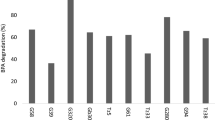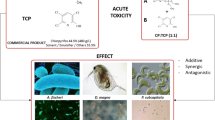Abstract
Pentachlorophenol (PCP) is a widespread contaminate of soils and ground water throughout North America. Earlier studies have indicated that microbial biodegradation leads to the formation of intermediate metabolites which are more toxic than the parent compound. Microbial degradation is by three general pathways: dechlorination, methylation, and oxidation. The relative toxicity of PCP and 25 of its identified intermediates of microbial transformation was evaluated in the static Tetrahymena pyriformis population growth assay. Dechlorination of chlorophenols resulted in a decrease in toxicity because of a decrease in both hydrophobicity and reactivity. Moreover, dechlorination of chloroanisoles resulted in a decrease in toxicity due to a decrease in hydrophobicity. Since there was a decrease in reactivity, methylation of chlorophenols resulted in a decrease in toxicity. Oxidation of chlorophenols resulted in enhanced toxicity owing to increased reactivity and concomitant decreased hydrophobicity.
Similar content being viewed by others
References
Bradbury SP, Henry TR, Carlson RW (1990) Fish acute toxicity syndromes in the development of mechanism-specific QSARs. In: Karcher W, Devillers J (eds) Practical applications of quantitative structure-activity relationships (QSAR) in environmental chemistry and toxicology. Kluwer Academic Publishers, Dordrecht, The Netherlands, pp 295–315
Bradbury SP, Henry TR, Niemi GJ, Carlson RW, Snarski VM (1989) Use of respiratory-cardiovascular responses of rainbow trout (Salmo gairdneri) in identifying acute toxicity syndromes in fish: Part 3 Polar narcotics. Environ Toxicol Chem 8:247–261
Bradbury SP, Lipnick RL (1990) Introduction: Structural properties for determining mechanisms of toxic action. Environ Hlth Prospect 87:181–182
Cajina-Quezada M, Schultz TW (1990) Structure-toxicity relationships for chemicals causing weak acid respiratory uncoupling. Aquatic Toxicol 17:239–252
Chaudhry GR, Chapalamadugu S (1991) Degradation of halogenated organic compounds. Microbiol Rev 55:59–79
Chu J, Kirsch EJ (1972) Metabolism of pentachlorophenol by an axenic bacterial culture. Appl Microbiol 23:1033–1035
— (1973) Utilization of halophenols by a pentachlorophenol metabolizing bacterium. Dev Ind Microbiol 14:264–273
Edgehill RU, Finn RK (1982) Isolation, characterization and growth kinetics of bacteria metabolizing pentachlorophenol. Eur J Appl Microbiol Biotechnol 16:179–184
— (1983) Microbial treatment of soil to remove pentachlorophenol. Appl Environ Microbiol 45:1122–1125
Federal Register. Vol. 56, No. 201, Thursday, October 17, 1991. Notices. Department of Health and Human Services, Agency for Toxic Substances and Disease Registry. Availability of Draft Toxicological Profiles, Washington, DC, 5236 pp
Ferguson J (1939) The use of chemical potentials as indices of toxicity. Proc R Soc London B 127:387–404
Golovleva LA, Zaborina O, Pertosova R, Baskunov B, Schurukhin Y, Kuzmin S (1992) Degradation of polychlorinated phenols by Streptomyces rochei 303. Biodegradation 2:201–208
Hansch C, Leo A (1979) Substituent constants for correlation analysis in chemistry and biology. John Wiley & Sons, NY, 339 pp
Hermens JLM (1990) Electrophils and acute toxicity to fish. Environ Hlth Perspect 87:219–225
Hunter RS (1988) Computer calculation of pKa. In: Turner JE, England MW, Schultz TW, Kwaak NJ (eds) QSAR 88 Proceedings 3rd international workshop on quantitative structure-activity relationships (QSAR) in environmental toxicology. CONF-880520–9DE88013180] NTIS, Springfield, VA, pp 33–42
Ide A, Niki Y, Sakamoto I, Watanabe H (1972) Decomposition of pentachlorophenol in paddy soil. Agric Biol Chem 36:1937–1944
Kamlet MJ, Doherty RM, Veith GD, Taft RW, Abraham MH (1986) Solubility properties in polymers and biological media. 7. An analysis of toxicant properties that influence inhibition of bioluminescence in Photobacterium phosphoreum (The Microtox Test). Environ Sci Technol 20:690–695
Kawatsuka S, Igarashi M (1975) Degradation of PCP in soils II. The relationship between the degradation of PCP and the properties of soils, and the identification of the degradation products of PCP. Soil Sci Plant Nutri 21:405–414
Knackmuss HJ, Hellwig M (1978) Utilization and cooxidation of chlorinated phenols by Pseudomonas sp. B13. Arch Microbiol 117:1–7
Lamar RT, Dietrich DM (1990) In situ depletion of pentachlorophenol from contaminated soil by Phenerochaete spp. Appl Environ Microbiol 56:3093–3100
Leo A, Weininger D (1988) Medchem software release 3.53, Pomona Medical Chemistry Project, Pomona College, Claremont, CA
Liu D, Thomson K, Strachan WMJ (1981) Biodegradation of pentachlorophenol in a simulated aquatic environment. Bull Environ Contam Toxicol 26:85–90
Lipnick RL, Watson KR, Strausz AK (1987) A QSAR study of the acute toxicity of some industrial organic chemicals to goldfish. Narcosis, electrophile and proelectrophile mechanisms. Xenobiotica 17:1011–1025
McKim JM, Bradbury SP, Niemi GJ (1987a) Fish acute toxicity syndromes and their use in the QSAR approach to hazard assessment. Environ Hlth Perspect 71:171–186
McKim JM, Schmieder PK, Carlson RW, Hunt EP, Niemi GJ (1987b) Use of respiratory-cardiovascular responses of rainbow trout (Salmo gairdneri) in identifying acute toxicity syndromes in fish: Part 1. Pentachlorophenol, 2,4- dinitrophenol, tricaine methane-sulfonate and 1-octanol. Environ Toxicol Chem 6:295–312
Mekenyan OG, Veith GD (1993) Relationships between descriptors for hydrophobicity and soft electrophilicity in predicting toxicity. In: SAR and QSAR in environmental research (in press)
Middaugh DP, Resnick SM, Lantz SE, Heard SE, Mueller JG (1993) Toxicological assessment of biodegraded pentachlorophenol; Microtox and fish embryos. Arch Environ Contam Toxicol 24:165–172
Mileski GJ, Bumpus JA, Jurek, MA, Aust SD (1988) Biodegradation of pentachlorophenol by the white rot fungus, Phanerochaete chrysosporium. Appl Environ Microbiol 54:2885–2889
Mueller JG, Middaugh DP, Lantz SE, Chapman PJ (1991) Biodegradation of creosote and pentachlorophenol in contaminated groundwater: Chemical and biological assessment. Appl Environ Microbiol 57:1277–1285
Murthy NBK, Kaufman DD, Fries GF (1979) Degradation of pentachlorophenol (PCP) in aerobic and anaerobic soil. J Environ Sci Hlth B 14:1–14.
Neilson AH, Allard AS, Hynning PA, Remberger M, Lander L (1983) Bacterial methylation of chlorinated phenols and guaiacols: Formation of veratroles from guaiacols and high-molecular weight chlorinated lignin. Appl Environ Microbiol 45:774–783
Perrin DD, Dempsey B, Sergeant EP (1981) pKa prediction for organic acids and bases. Chapman & Hall, London, p 146
Reiner EA, Chu J, Kirsch EJ (1978) Microbial metabolism of pentachlorophenol. In: Rao KR (ed) Pentachlorophenol. Plenum Press, NY, pp 67–81
Saber DL, Crawford RL (1985) Isolation and characterization of Flavobacterium strains that degrade pentachlorophenol. Appl Environ Microbiol 50:1512–1518
SAS Institute Inc. (1989) SAS/STAT user's guide, version 6, 4th edition, 2. Cary, NC, pp 846
Schultz TW, Cajina-Quezada M (1982) Structure-toxicity relationships of selected nitrogenous heterocyclic compounds II. Dinitrogen molecules. Arch Environ Contam Toxicol 11:353–361
Schultz TW, Holcombe GW, Phipps GL (1986) Relationships of quantitative structure-activity to comparative toxicity of selected phenols in the Pimephales promelas and Tetrahymena pyriformis test systems. Ecotoxicol Environ Saf 12:146–153
Schultz TW, Lin DT, Wilke TS, Arnold LM (1990) Quantitative structure-activity relationships for the Tetrahymena pyriformis population growth endpoint: A mechanisms of action approach. In: Karcher W, Devillers J (eds) Practical applications of quantitative structure-activity relationships (QSAR) in environmental chemistry and toxicology. Kluwer Academic Publishers, Dordrecht, The Netherlands, pp 241–262
Spokes JR, Walker N (1974) Chlorophenol and chlorobenzoic acid cometabolism by different genera of soil bacteria. Arch Microbiol 96:125–134
Suzuki T (1977) Metabolism of pentachlorophenol by a soil microbe. J Environ Sci Hlth B 12:113–117
— (1983a) Metabolism of pentachlorophenol (PCP) by soil microorganisms. Bull Nat Inst Agric Sci (Jpn) C38:69–120
— (1983b) Methylation and hydroxylation of pentachlorophenol by Mycobacterium sp. isolated from soil. J Pest Sci 8:419–428
Stanlake GJ, Finn RK (1982) Isolation and characterization of a pentachlorophenol-degrading bacterium. Appl Environ Microbiol 53:907–910
Terada H (1990) Uncouplers of oxidative phosphorylation. Environ Hlth Prospect 87:213–218
Veith GD, Broderius SJ (1987) Structure-toxicity relationships for industrial chemicals causing type (II) narcosis syndrome. In: Kaiser KLE (ed) QSAR in environmental toxicology—II. D Reidel Publishing Co, Dordrecht, The Netherlands, pp 385–391
— (1990) Rules for distinguishing toxicants that cause type I and type II narcosis syndromes. Environ Hlth Prospect 87:207–211
Veith GD, Call D, Brooke L (1983) Structure-toxicity relationships for the fathead minnow, Pimephales promelas: Narcotic industrial chemicals. Can J Fish Aquat Sci 40:743–748
Watanabe I (1973) Degradation of pentachlorophenol (PCP) by soil microorganisms. Soil Microorg Jpn 14:19–39
Author information
Authors and Affiliations
Rights and permissions
About this article
Cite this article
Bryant, S.E., Schultz, T.W. Toxicological assessment of biotransformation products of pentachlorophenol: Tetrahymena population growth impairment. Arch. Environ. Contam. Toxicol. 26, 299–303 (1994). https://doi.org/10.1007/BF00203555
Received:
Revised:
Issue Date:
DOI: https://doi.org/10.1007/BF00203555




